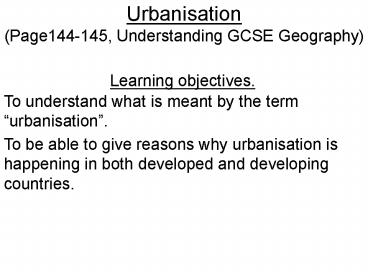Urbanisation (Page144-145, Understanding GCSE Geography) PowerPoint PPT Presentation
1 / 17
Title: Urbanisation (Page144-145, Understanding GCSE Geography)
1
Urbanisation(Page144-145, Understanding GCSE
Geography)
- Learning objectives.
To understand what is meant by the term
urbanisation. To be able to give reasons why
urbanisation is happening in both developed and
developing countries.
2
Starter
This is a picture of part of the worlds largest
city by population. Whats its name and which
country is it in?
3
Answer
Tokyo, Japan which has a population of
34.3million in the whole conurbation.
4
In 2007, for the first time in history more
people lived in cities than in rural areas.In
2011 the Worlds population had grown to 7 billion
(7,000,000,000), so it is estimated that nearly 4
billion people now live in cities.The World has
undergone a rapid urbanization.
5
In the UK about 90 of the population lives in
urban areas. The graph below shows how the urban
population has changed in the UK since 1800.
Urban population growth in the UK, 1800-2000.
6
Definition of Urbanisation
Urbanization is a process of urban growth that
leads to a greater percentage of the population
living in towns and cities. Quite simply, this
means that more and more people are living in
towns and cities, and less and less people living
in the countryside (rural areas).
7
Cities in developed countries.Towns and cities
grew rapidly during the Industrial Revolution,
mostly in the 1800s. At the time jobs were being
lost in the countryside. An agricultural
revolution brought new machinery
(mechanization) that meant less work was
available in the rural areas. People moved from
the countryside to the towns for new jobs in the
shipyards, mines and factories.
They lived in the rows of terraced housing built
in the inner cities.
8
In the late twentieth century the very large
urban areas began to lose population especially
from the run-down areas of inner cities (called
counter-urbanization). Development schemes in
many cities are now trying to attract people back
into the cities.
London docklands, an example of a development
scheme.
9
Cities in developing countries. Cities began to
grow rapidly particularly after 1950. This was
much later than in developedountries. The growth
has also been much faster, double the rate of the
developed countries. Urbanization was caused by
- rural to urban migration, a result of push and
pull factors.
- high birth rates in the cities.
10
The developing world now have most of the world's
largest cities the fastest growing are mostly
located in the tropics.
Growth and distribution of millionaire cities.
11
In rich countries, many more people live in urban
areas than in poorer countries. In developing
countries, the urban population is still lower
than the rural population, i.e. more people still
live in rural areas in developing countries.
12
It is the very largest cities that have grown the
most. In 1900 there were only two cities with
over one million people London and New York.
These were called millionaire cities. Now there
are over 300 millionaire cities. In 2000 the ten
largest cities had over 10 million people. These
are called megacities.
13
Task
Do the Megacities worksheet.
14
The growth of Cairo.
Most of the worlds fastest growing cities are in
poor countries. Countries like Egypt have a fast
growing population and a fast rate of internal
migration to the cities.
15
Population density in Egypt.
16
TaskDo Activities 1 and 2 on page 155.
17
- Key points for you to know for revision.
- 1. The rate of urbanization in the 20th century
has been very rapid, and most of the growth in
the cities has been in the developing countries.
- Urbanization happened much earlier in developed
countries (mostly during the industrial
revolution). This was mainly because of the
growth of industrialization and mechanization of
agriculture. - Most of the worlds megacities (with a population
of over 10million people) are now in poorer
countries. Some say Mexico City is the worlds
largest city, others say Tokyo. This is because
getting accurate census information is difficult.

